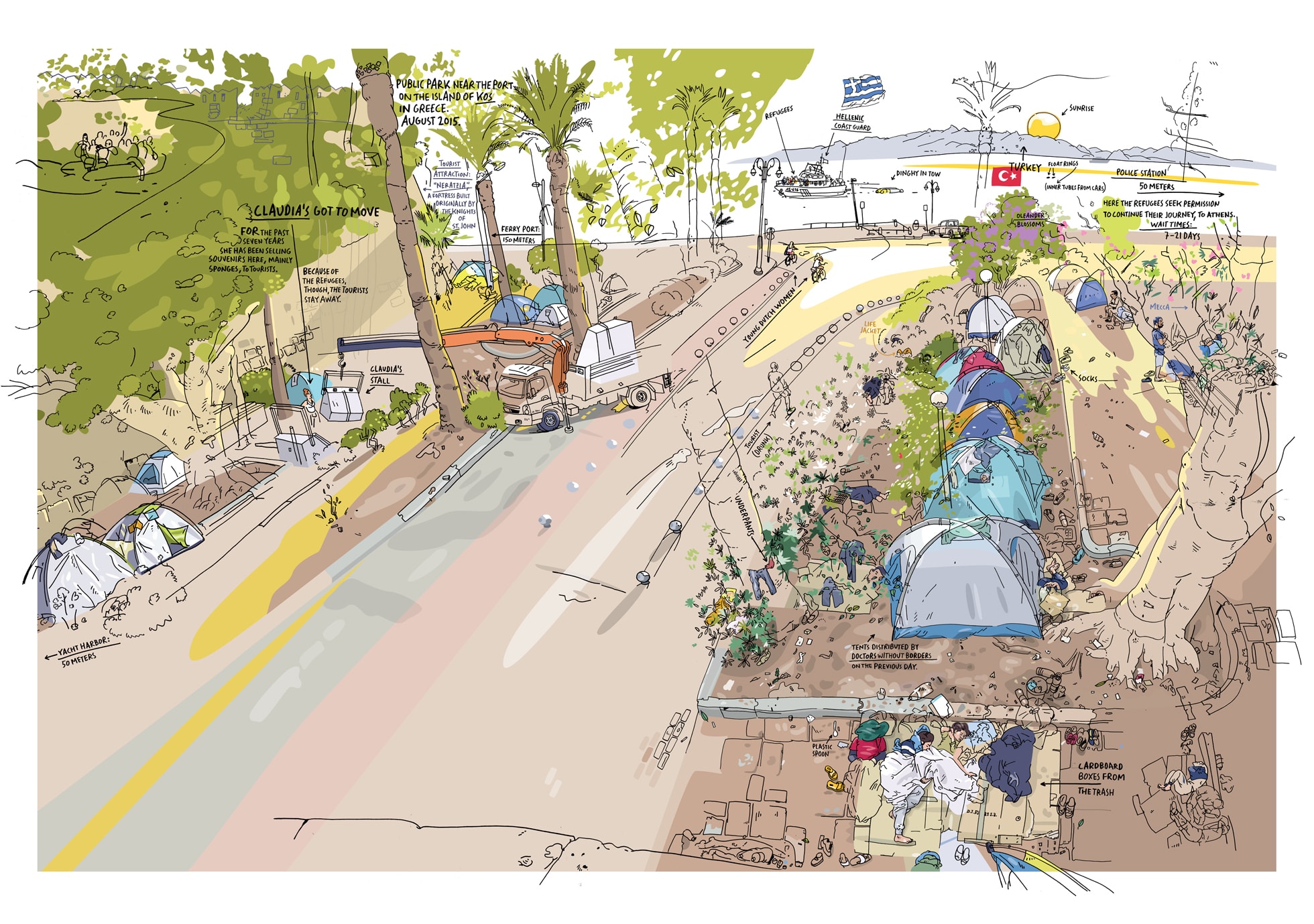
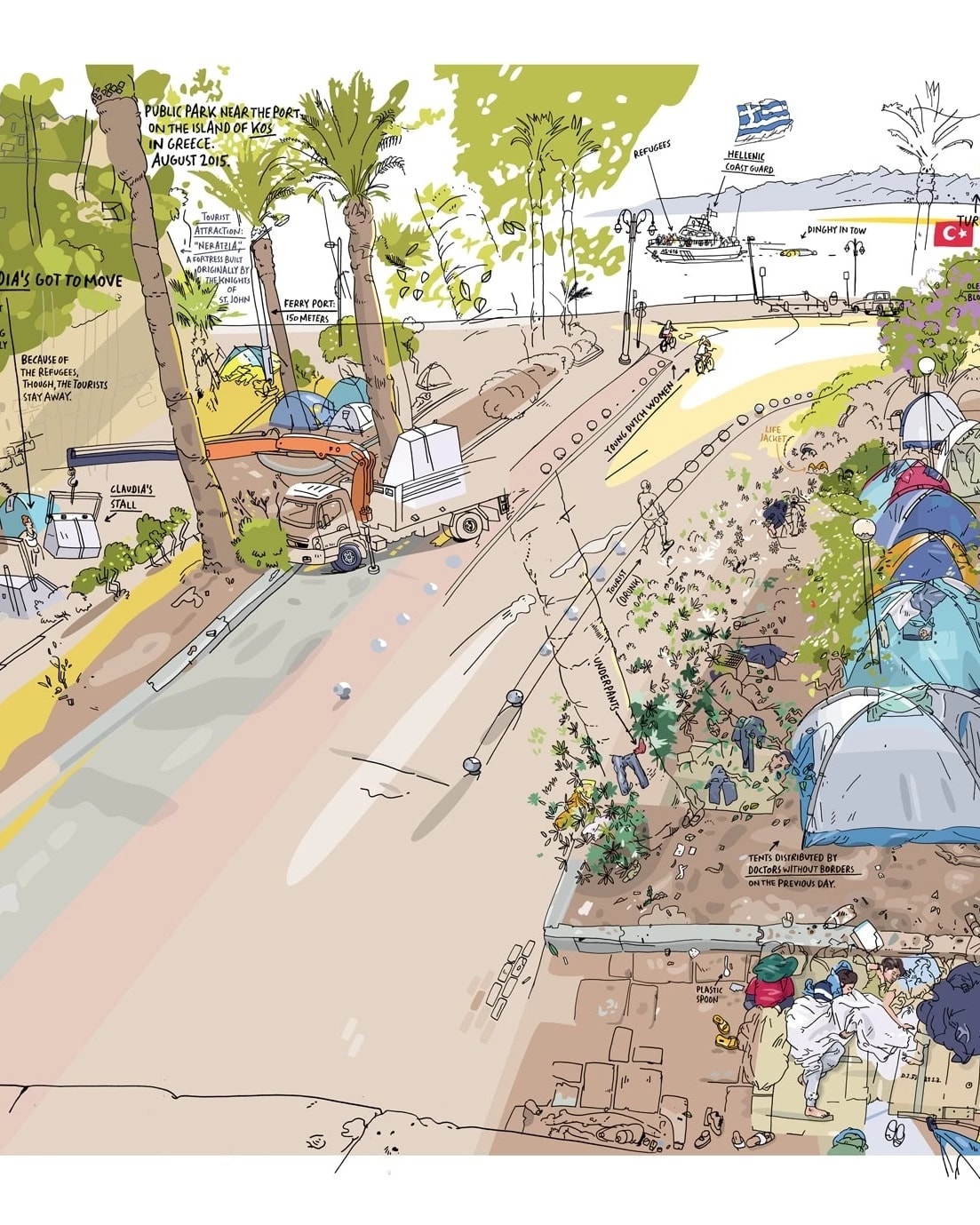
The opening spread of illustrator Olivier Kugler's February 2016
Harper's Magazine
feature,
about a Syrian refugee camp on the Greek island of Kos. Courtesy Olivier Kugler.
The opening spread of illustrator Olivier Kugler's February 2016
Harper's Magazine
feature,
about a Syrian refugee camp on the Greek island of Kos. Courtesy Olivier Kugler.
In 2009, illustrator Olivier Kugler (MFA 2002 Illustration as Visual Essay) flew from his home in London to Istanbul, from where he traveled by train to Tehran. While in Tehran he met a local truck driver who invited him along on a four-day drive across the country, north to south, to deliver a load of bottled water to Kish, a small island in the Persian Gulf. Kugler recorded this unusual journey and turned it into a 30-page piece of beautifully drawn reportage that was published in the French international affairs magazine XXI.
Not only did the story take top prize in the 2011 V&A Illustration Awards, given by the Victoria & Albert Museum in London and considered within the UK to be the industry’s highest honor, it was something of a personal milestone for the artist because it was the culmination of a much greater journey, one that began at SVA in 2000.
Born in 1970 in Stuttgart, Germany, Kugler began his working life as a graphic designer, but soon found himself bored with the field, and applied for and won a scholarship to SVA's MFA illustration program. He wanted, he says, to "become a better draftsman."
While at SVA, he spent much of his time sketching at locations around New York City, and as he drew he found himself eavesdropping on conversations around him. "I didn't do it consciously," he says, "but when I heard something interesting I would just scribble it on my drawing." His instructors and fellow students thought the quotes, and his other written observations, a novel touch, and it was clear to Kugler that the words added a narrative element that set his work apart.
If you look at his portfolio, it is clear Kugler loves machinery. Not the shiny new kind, but things old, battered and rusted. And in New York, on the route from his Spanish Harlem apartment to the nearby subway stop, he found a parking lot that was home to some particularly appealing wrecks. So on one chilly winter's day, he set down his camping chair, settled on a particular junked car that caught his fancy, and began drawing. He'd been working about an hour when to his surprise a door opened and a man stepped out. He was homeless and the car was where he slept. Kugler asked the man if he could draw him and the man said yes, for $10. Kugler paid and the man introduced himself as Alberto and began to tell his story: how he was from Puerto Rico and had been a chef until he became a drug addict and ended up on the street, scavenging the neighborhood for saleable junk. As Alberto talked, Kugler continued to sketch. "I didn't plan it," he says now, "but in the end I had a series of drawings about this one guy and his life story. It turned into a visual essay."
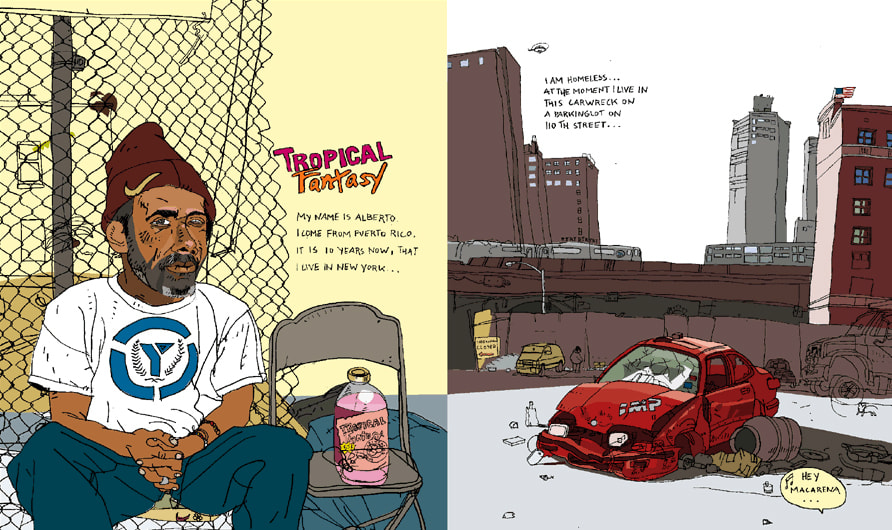
A sketch from Olivier Kugler's
on Alberto, a homeless man Kugler met while studying at SVA. Courtesy Olivier Kugler.
Since graduating, Kugler has lived with his girlfriend in London, working for clients from all over the world, including GQ (Germany), Harper’s, Le Monde Diplomatique, The New York Times and The New Yorker. Most of the commissions have been for spot illustrations, but in 2005 a supportive editor at the UK newspaper The Guardian gave him valuable page space to develop his signature style of portraiture, in a series that ran as "Kugler's People." In this series, Kugler drew his sitters in their everyday environment—the gym, a prison cell or a trailer park—cramming the frame with all manner of background detail. Squeezed in and around all this are hand-lettered passages of transcribed conversation. Not only do you see Kugler's people, you listen to them, too.
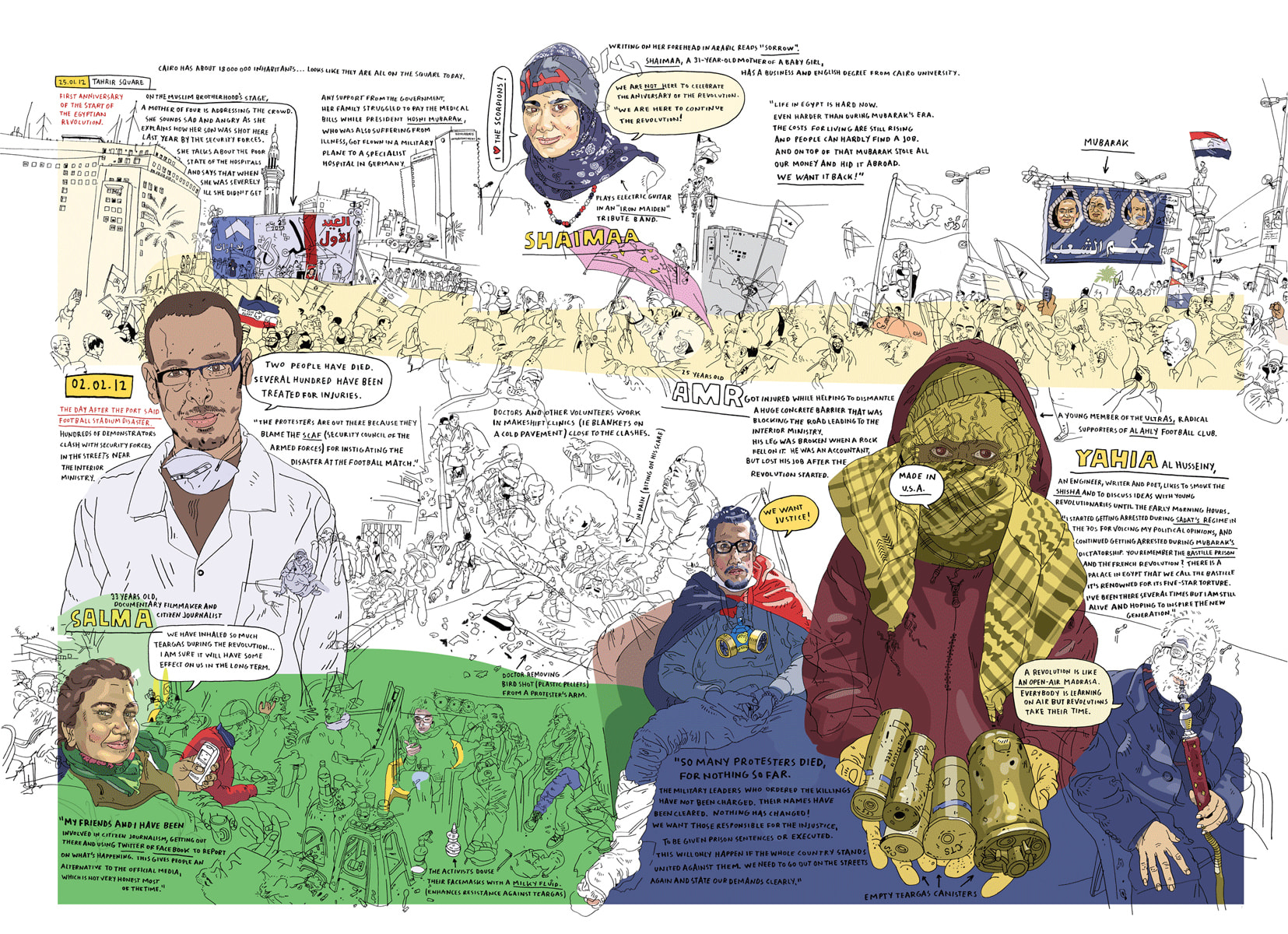
UK newspaper
The Guardian
sent Kugler to Egypt in 2012
to report on the country's revolution
. Courtesy Olivier Kugler.
The Guardian has also assigned him to report on the "new" China, in 2005, to follow British politicians on the campaign trail, in 2011, and to file from Cairo's Tahrir Square in 2012 during the Egyptian revolution. But, not surprisingly, given the European tradition of graphic novels (bande dessinée), it was a French publisher—XXI magazine—that gave him his first opportunity to create a longer-form piece of work.
XXI is a beautifully produced, square-bound brick of a magazine that uses only illustration to accompany reporting from around the world. It is a type of periodical sadly absent from the English-speaking (or -reading) world. Two years after publishing Kugler’s account of his Iranian road trip, XXI ran another 30-page story of his, this one on a week spent in Laos shadowing a French veterinarian who was treating elephants that worked in the region’s logging industry. (This work was later released as a book, by Swiss publishing house Edition Moderne.)
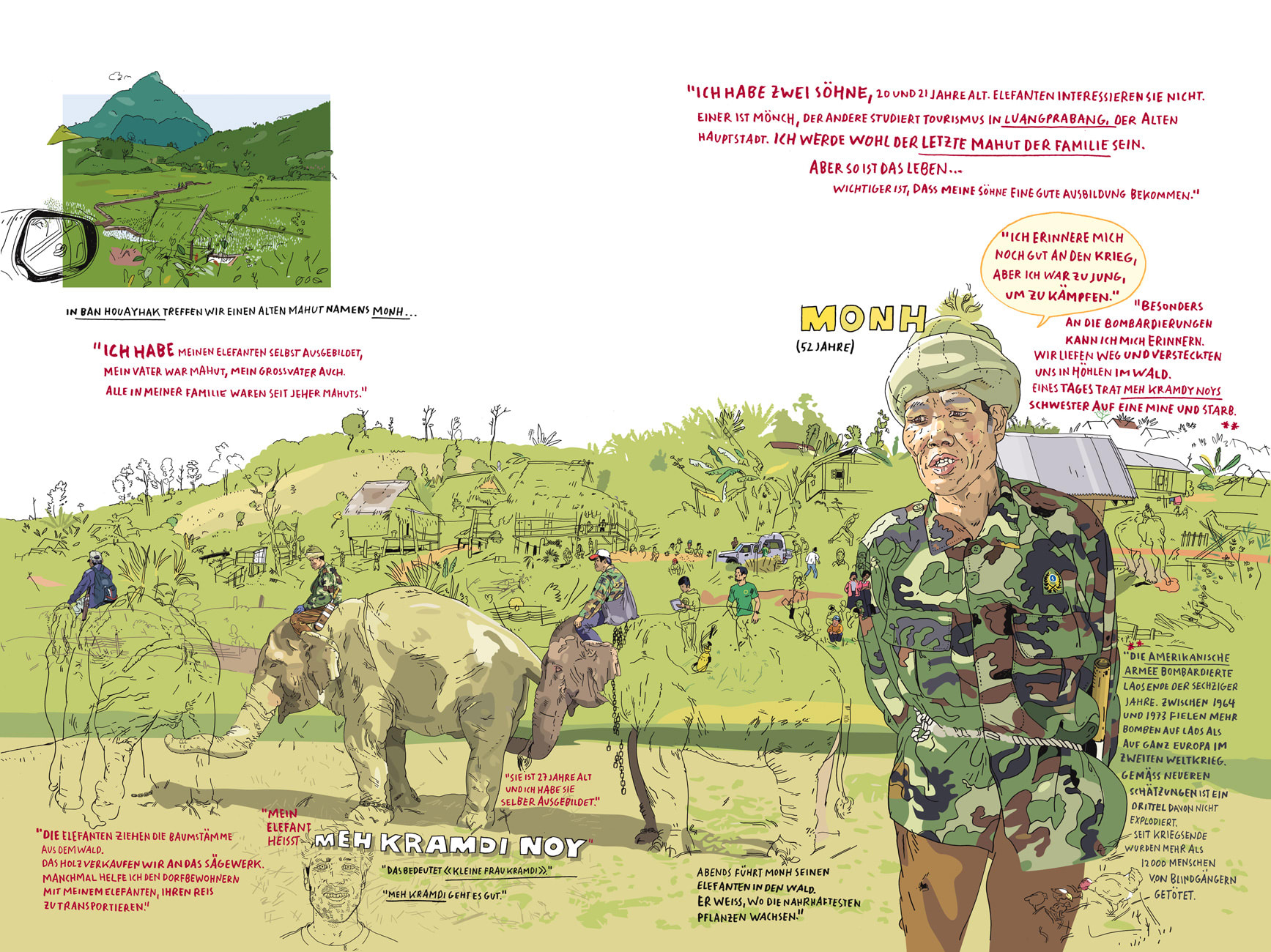
A spread from
on elephants working in Laos' logging industry, and the veterinarian who treats them, for French magazine
XXI.
Courtesy Olivier Kugler.
Now, Kugler is planning another story for XXI, except this time 30 pages will only constitute a brief extract of a much larger endeavor. In December 2013, as part of an effort to publicize its work, the international humanitarian aid organization Doctors Without Borders (Médecins Sans Frontières) sent Kugler to make drawings in the Domiz refugee camp in Iraqi Kurdistan, to help publicize its work with the people living there. Over the course of two weeks, he met and interviewed Syrians who had fled their country’s ongoing civil war. Kugler has since traveled to Greece, Switzerland, Germany and France, interviewing more refugees as they make their way north, looking for a safe haven. Portions of this work have been published in Harper's Magazine, in March 2014 and in February of this year. His plan is to bring all of these stories together in a book that puts a human face on what is turning out to be the greatest movement of displaced people across Europe since World War II.
It is an almost overwhelming undertaking, although in some ways Kugler’s process is simplified by the economic realities. Although he is aided by a grant from Arts Council England, a national arts-funding organization, he is funding the project as he goes along and relies on commissions, mostly from Doctors Without Borders, to gain access to the refugees and to pay his way.
His method of working involves little in the way of pre-planning. He simply walks around looking for objects or settings that he would like to draw, a list that might include cars and bikes, pipes, wiring, workshops, barber shops, tea carts, stoves, boats and general clutter. Once he has found something of visual interest, he will strike up a conversation with whomever is nearby, using the services of a translator to ask questions. Instead of a sketchbook, he carries a digital recorder to tape his interviews, and a camera. Sketching, he says, is inefficient when he has such limited time on the ground. Instead, he takes hundreds of photographs. Each evening, he reviews the day’s work and plots scenes in a notebook, sketching rough compositions and page layouts. Only when he is back in his East London studio does he begin making line drawings based on his photographs. These are then scanned and imported into Freehand, an old competitor program to Adobe Illustrator that is no longer commercially available. Working with a program like this allows Kugler to move elements around onscreen in search of the ideal composition, and also to add color.
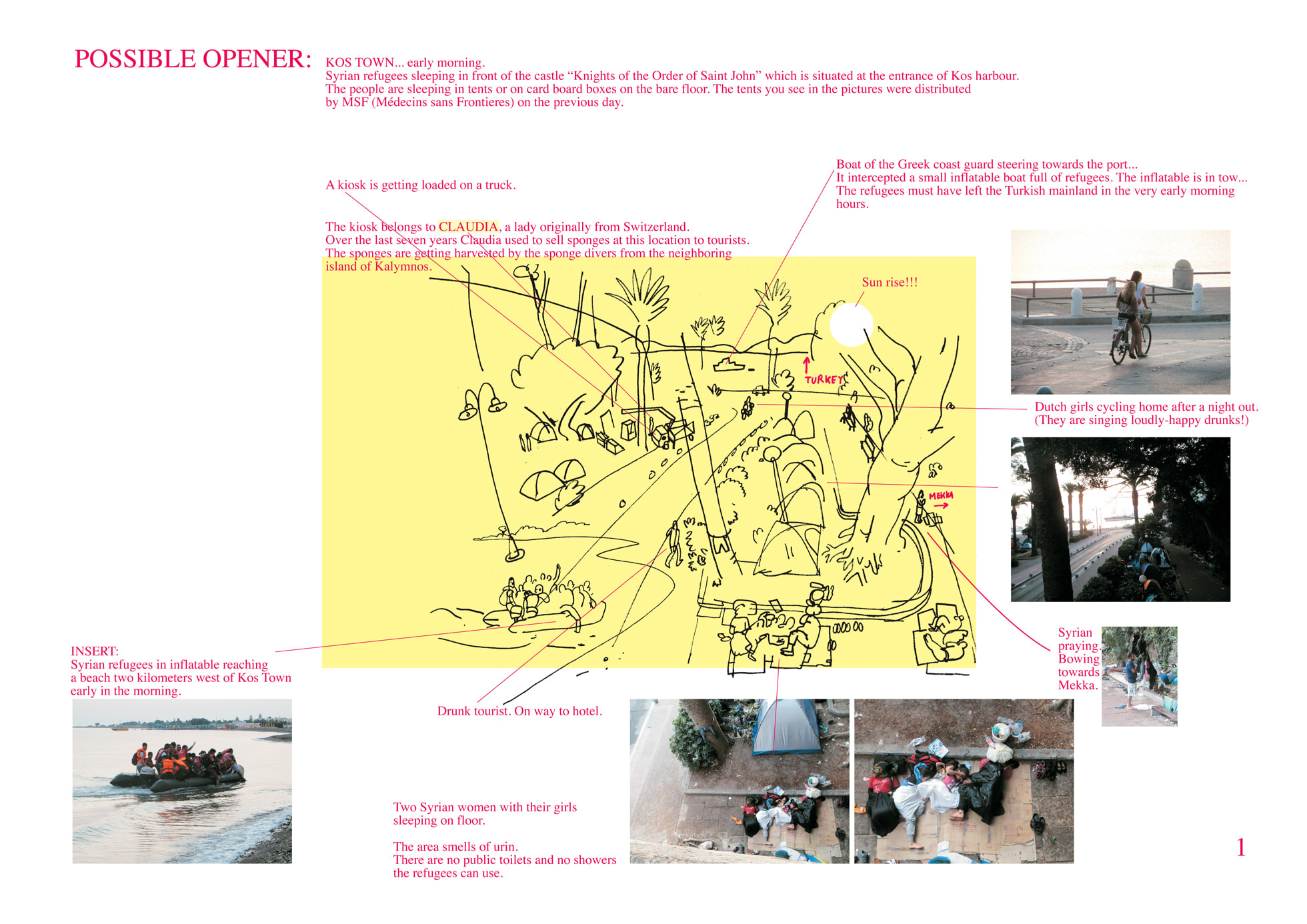
Since drawing is time- and attention-consuming, Kugler photographs and makes audio recordings while reporting, then sketches out his ideas later. Here, a rough sketch for the opening spread of
with notes and reference photos. Courtesy Olivier Kugler.
He has set himself a 2017 deadline to complete his refugee book but acknowledges that if he isn't careful, it could just go on and on. "This is a problem I am facing at the moment," he says. "I don’t know where to 'draw the line.'"
External forces might conspire to shape his schedule for him: later this year his girlfriend is moving to Ghana to take a new job, and Kugler—as well as their young son—will be going, too. Rather than worrying about the disruption it might mean for his work, he is excited by the prospect. "I've just seen a story on the BBC," he says. "There are some Syrian refugees who wound up in Ghana."
Andrew Humphreys is a London-based travel journalist and author, and the founder of Paradise Road publishing house.
A version of this article appears in the fall 2016 issue of the Visual Arts Journal.

